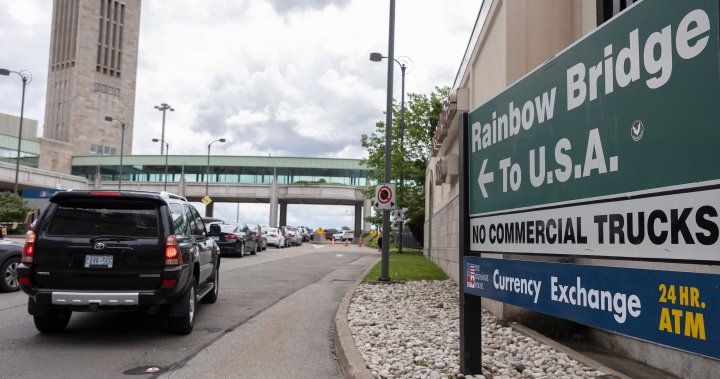Jobs
Liberals say they will rein in temporary foreign worker program after historic influx | CBC News
Housing Minister Sean Fraser said Sunday that the federal government will curb the number of temporary foreign workers (TFWs) coming into the country after a post-COVID surge that some researchers say has driven up youth and immigrant unemployment rates.
Speaking to reporters in Dartmouth, N.S., before the start of a Liberal cabinet retreat in neighbouring Halifax, Fraser justified the government’s past decision — made while he was immigration minister — to relax regulations around the TFW program as necessary at a time of pandemic-related staff shortages.
But he acknowledged that the dynamic is different now that there are signs of stress in the labour market.
Unemployment rates among immigrants and young people have crept up to concerning levels in recent months, according to federal data.
“The landscape has changed. We don’t see that acute labour shortage that existed even two years ago. As the economic landscape changes, so too must the policy landscape,” Fraser said.
“You should expect to see in the future additional changes that will ensure that the programs we put in place to help grow the Canadian labour force first and foremost create opportunities for Canadian workers.”
Fraser did not offer any specifics as to how many TFWs will be admitted in the future or what aspects of the program could change now that the government has identified the program’s explosive growth as a problem.
The minister said Canada can absorb the number of new permanent residents being added each year — the country will admit an expected 485,000 immigrants in 2024 — but conceded that non-permanent immigration programs allowing foreign workers and students to come here on a short-term basis are putting stress on an already strained housing supply.
Fraser said the temporary foreign worker program has historically been driven by what employers say they need without much of a hard cap. The government could impose more restrictions to get those numbers down, he said, while still accommodating those businesses that truly need the program to build a workforce.
TFW regulations relaxed post-COVID
The agricultural sector has long relied on TFWs to grow and harvest the food the country eats and exports.
“We’ve seen such a significant increase despite the fact we no longer have the labour shortage in existence to the degree it was two summers ago. That demands we take a different approach,” Fraser said.
The number of non-permanent residents has been growing at a breakneck pace in the post-COVID era after the federal government relaxed regulations around TFWs — especially in the “low-wage” stream — and allowed Canada’s colleges and universities to dramatically expand the international student body.
In the last three years, the number of non-permanent residents — a category that includes TFWs, international students and asylum seekers — has more than doubled from about 1.3 million in 2021 to nearly 2.8 million in the second quarter of this year, according to data compiled by Statistics Canada.
Of that figure, 1.3 million people are in Canada on work permits — a category that includes TFWs.
The low-wage TFW sector — which has admitted workers in food service but also in sectors like construction and hospitals — has grown from 15,817 such workers in 2016 to 83,654 in 2023, according to federal data.
The reason the numbers are so much higher than years’ past is that the federal government lifted a restriction in April 2022 that essentially forbade employers in high-unemployment regions — those with an unemployment rate of six per cent or higher — from hiring low-wage foreign workers in some occupations.
Ottawa also increased the proportion of low-wage TFWs a company could employ from 10 per cent to 20 per cent — with a higher 30 per cent limit for some industries like accommodations and food services. In March, the 30 per cent limit was again reduced to 20 per cent.
Canadian businesses were given the green light to fill roughly 240,000 jobs with temporary foreign workers in 2023, more than twice as many as they were a half-decade earlier. CBC’s Paula Duhatschek looks at the divided opinions and experiences behind the surging numbers.
As a result of the more lax regulations, there’s been an uptick in businesses like Tim Hortons and convenience store chains bringing in workers from abroad to fill supposed labour shortages — even in areas where the unemployment rate among locals is high. There’s also been an increase in foreign workers getting entry-level office jobs.
A recent United Nations report dubbed Canada’s TFW program — in which foreign workers are linked to a specific program for a set period of time — a breeding ground for modern slavery.
Youth, immigrant jobless rates rise
Researchers suggest that the massive influx of low-wage foreign workers has had a detrimental effect on the employment prospects of immigrants and young people.
According to the Bank of Canada’s recent monetary report, the “newcomer” or immigrant unemployment rate now stands at 11.6 per cent — well above the overall unemployment rate of 6.4 per cent that was recorded in June.
“The softening of the labour market has made it even harder for newcomers to find a job and be attached to the labour force,” the central bank said in its July monetary report.
Notably, the unemployment rate of immigrant and Canadian-born Black people is 11.9 per cent, according to Statistics Canada data.
For youths, which includes people between the ages of 15 and 24, the unemployment rate is even higher at 13.5 per cent — the highest it’s been in a decade, according to federal figures.
“Young Canadian workers are having an exceptionally tough summer,” said Mike Moffatt, the senior director of policy at the Smart Prosperity Institute, a think-tank based at the University of Ottawa.
He pointed to Canada’s Labour Force Survey, which shows that the number of young people between 15 and 19 who worked last month was the second lowest on record, only slightly ahead of the pandemic lockdown year of 2020.
“Outside of 2020, when we were in lockdown, 2024 has been the worst year on record for teenagers to get a summer job, whether as a cashier at a convenience store or selling ice cream,” Moffatt said in a recent post on the issue.
“Despite the challenges teenagers are currently having in the job market, the number of temporary foreign workers approved for those same positions has never been higher.”
A scathing United Nations report released last month denounces Canada’s temporary foreign worker program as a “breeding ground for contemporary forms of slavery,” citing wage theft, excessive work hours, limited breaks and physical abuse as some of the ways workers are being mistreated.
In a recent interview with CBC’s Power & Politics, Moffatt said he would like to see the government end the low-wage TFW stream entirely to restore some balance to the lower end of the labour market, where immigrants and young people are competing against imported workers who are sometimes willing to work for less than what others would accept.
Moffatt, who’s among the presenters who will be meeting with the federal cabinet at its retreat in Halifax, will have the chance to make the pitch directly to the prime minister.












